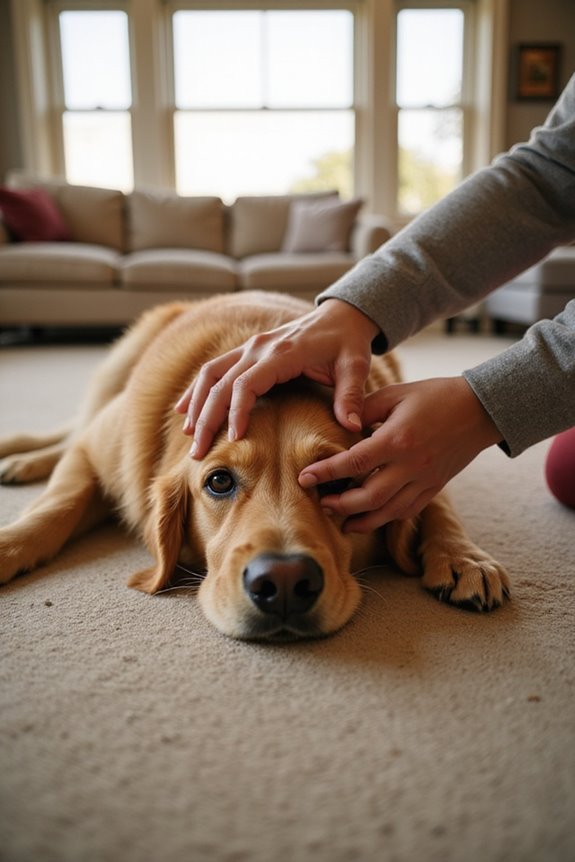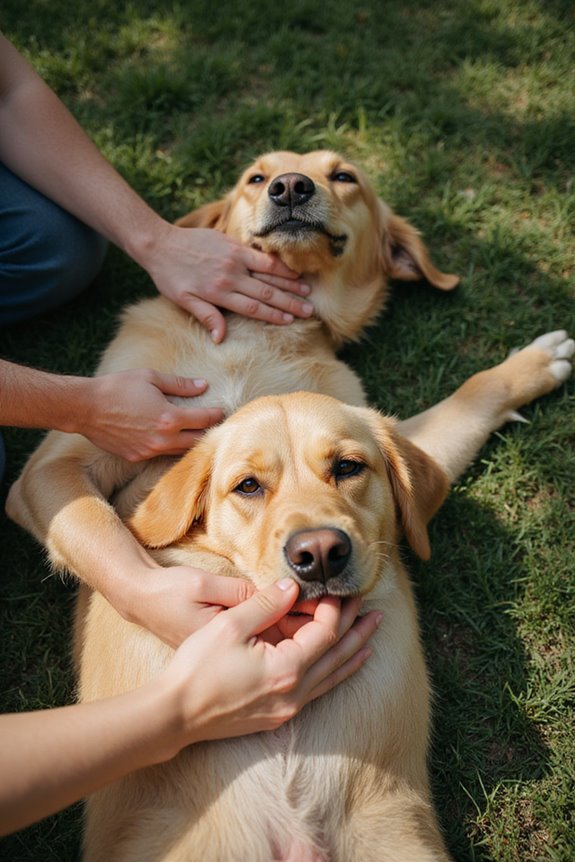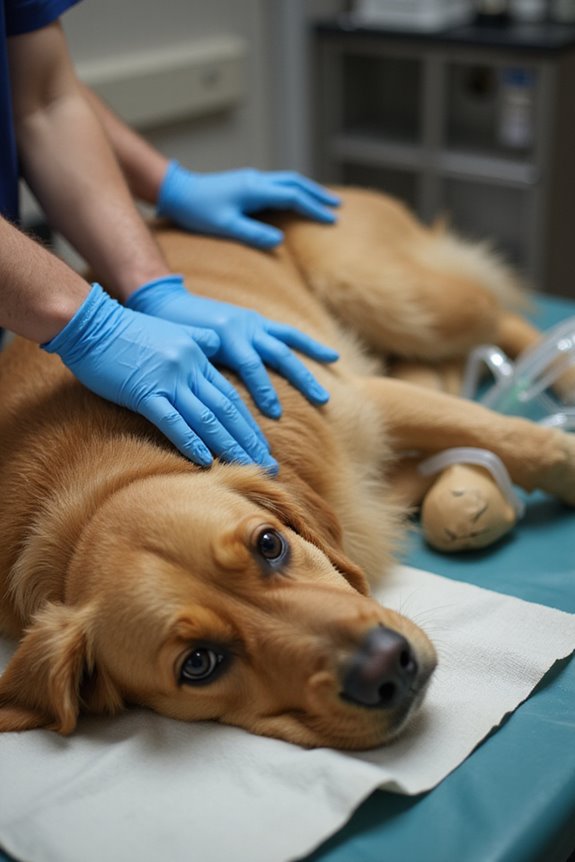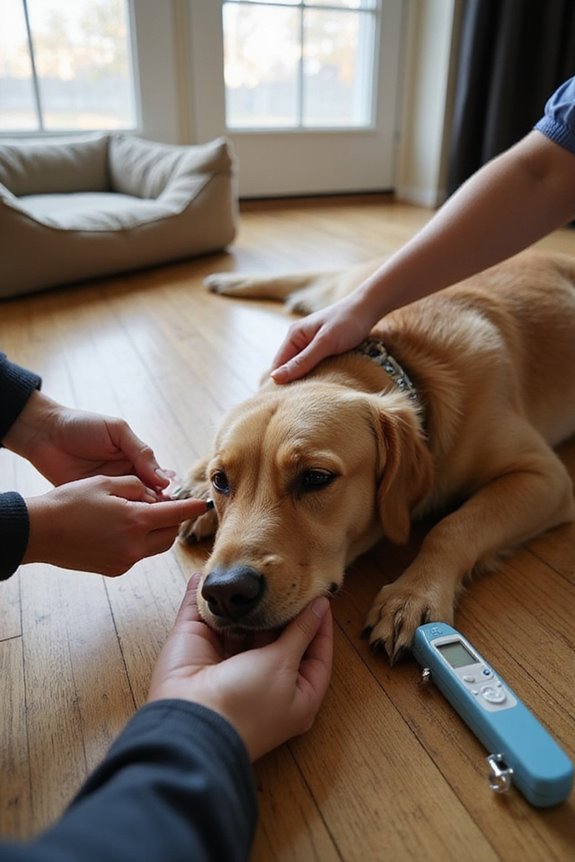When a dog is unconscious, act quickly. First, verify your safety and assess the environment for hazards. Clear the airway by gently opening the mouth and removing any obstructions. If breathing doesn’t resume, perform rescue breathing by closing the mouth and sealing around the nostrils, delivering about 20 breaths per minute. If there’s no pulse, begin CPR with 30 chest compressions followed by 2 breaths. Watch for signs of shock and seek immediate veterinary care for proper treatment and guidance.
Key Takeaways
- Assess the environment for hazards and ensure personal safety before approaching the dog.
- Check for visible injuries and the dog’s posture to determine stability.
- Clear the airway by opening the mouth and removing any obstructions carefully.
- Perform rescue breathing by sealing the nostrils and delivering 20 gentle breaths per minute.
- Initiate CPR with 30 chest compressions followed by 2 rescue breaths, continuing until help arrives.
Assessing the Situation and Ensuring Safety
When you encounter an unconscious dog, it’s essential to act swiftly and methodically, as every second counts in ensuring the animal’s safety and overall well-being. First, I always prioritize identifying hazards in the environment, ensuring the area is free from traffic, aggressive animals, or harmful objects. Next, I carefully approach the dog while observing behavior, checking for any signs of consciousness or movement. It’s vital to assess for visible injuries, especially bleeding or trauma, while ensuring personal safety. Positioning myself for a clear escape route is also key, as the dog may regain consciousness unexpectedly. Finally, I assess the dog’s posture, ensuring it is stable to facilitate further medical evaluation.
Clearing the Airway

Clearing the airway of an unconscious dog is a critical step that can be lifesaving, especially in cases of choking or obstruction. To begin, carefully restrain the dog to prevent injury, and gently open its mouth. Pull the tongue forward to inspect for visible obstructions. If you see something accessible, remove it by hand—never push it further down the throat.
If the obstruction is severe, apply airway techniques like the External Extraction Technique (XXT). Create a diamond shape with your fingers at the jaw’s “V” area, and use a gentle J-motion to remove the object. Remember, support the dog’s neck and avoid overextending it. Once any obstruction removal is complete, swiftly check for breathing and prepare for further assistance.
Performing Rescue Breathing

Performing rescue breathing is an essential skill that can greatly improve the chances of survival for an unconscious dog in distress. Here’s how to do it effectively:
- Positioning: Lay the dog on its side, extending the head and neck straight to keep the airway open.
- Breath Delivery: Close the mouth, then seal your mouth around the nostrils. Deliver about 20 gentle breaths per minute, ensuring you see a rise in the chest with each breath.
- Technique: Allow the chest to fall completely before the next breath to prevent over-inflation. For larger dogs, manually close one nostril to create an airtight seal.
- Monitoring: Watch for chest rise; if it doesn’t occur, reposition the airway or check for obstructions.
Implement these rescue techniques promptly for best results.
Administering Cardiopulmonary Resuscitation (CPR)

Administering cardiopulmonary resuscitation (CPR) is a critical next step after establishing an airway and providing rescue breaths for an unconscious dog.
- Compression Techniques: Use the “thoracic pump” method, compressing 1/3 to 1/2 the width of the chest. For small dogs, encircle the chest, while for larger dogs, compress over the heart area. Guarantee full chest recoil.
- Ventilation Ratios: Deliver 30 chest compressions followed by 2 rescue breaths, maintaining a rate of 100 to 120 compressions per minute. Alternate the compressor every 2 minutes to prevent fatigue.
- Cycles and Timing: Perform CPR in uninterrupted cycles, pausing briefly every 2 minutes to assess for breathing and heartbeat, without breaking the rhythm.
Keep going until the dog resumes breathing or professional help arrives.
Monitoring for Signs of Shock

Monitoring for signs of shock is essential, especially when your dog is unconscious, as early detection can greatly impact their chances of recovery. Understanding shock means being alert to recognizing symptoms that could worsen over time.
Key Signs to Monitor
- Breathing: Rapid, noisy, or labored breathing can indicate shock.
- Gum Color: Pale or bluish gums signal poor blood flow.
- Pulse: A rapid heart rate with a weak pulse is critical.
- Temperature: Cool limbs are a sign of reduced circulation.
- Mental State: Confusion, extreme lethargy, or inability to stand suggests serious distress.
Seeking Immediate Veterinary Care
Finding your dog unconscious can be alarming, and while it’s important to monitor for signs of shock, acting swiftly to seek veterinary care is essential. First, I’d recommend calling your veterinary clinic to alert them of the situation and arrange an emergency visit. If your usual vet isn’t available, go to the nearest animal emergency hospital right away.
When transporting your dog, handle them gently, avoiding further injury, and use a flat surface to keep them stable. Keep the airway open, and call the clinic en route to prepare them for your arrival. Follow their veterinary protocols regarding care. This attention guarantees that you can provide crucial information about your dog’s condition, facilitating effective emergency support.
Frequently Asked Questions
How Can I Tell if My Dog Is Unconscious or Asleep?
When I check my dog’s sleep patterns, I look for health indicators. If he doesn’t respond to my voice or touch, I get worried—it could mean he’s unconscious instead of just sleeping peacefully.
What Common Causes Can Lead to a Dog Becoming Unconscious?
You’d think my dog’s just napping, but seizures or heatstroke might sneak up on him. Common causes of unconsciousness include various heart issues, brain conditions, and oxygen deprivation—definitely not the best nap companion I ever had!
Should I Administer First Aid if My Dog Is Breathing but Unresponsive?
If your dog’s breathing but unresponsive, I’d want you to stay calm and use first aid techniques. Evaluating responsiveness is vital—place them in recovery position, monitor closely, and seek vet help immediately. Your pup needs you!
How Can I Prevent My Dog From Becoming Unconscious in the Future?
To keep my fur baby from fainting, I embrace preventive measures and regular health monitoring. Creating a calm haven, managing diet, and staying alert to their needs makes all the difference in our lives together.
What Items Should Be in a Pet First Aid Kit for Emergencies?
When building a pet first aid kit, I’d include various bandage types, antiseptics, and emergency contacts. It’s comforting to know I can respond quickly to any situation that arises with my furry friend.



